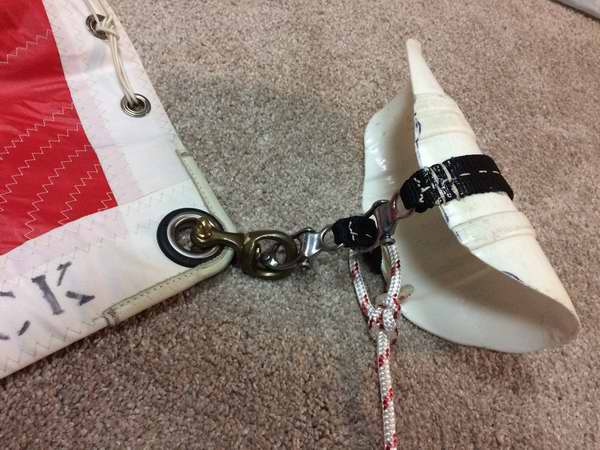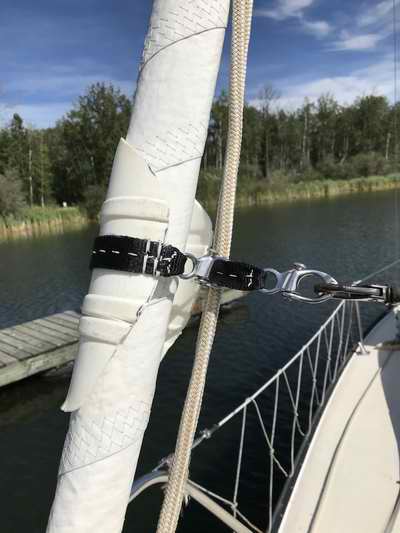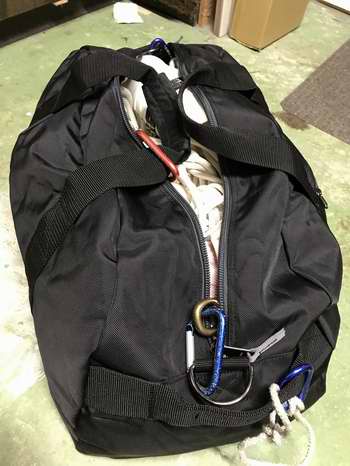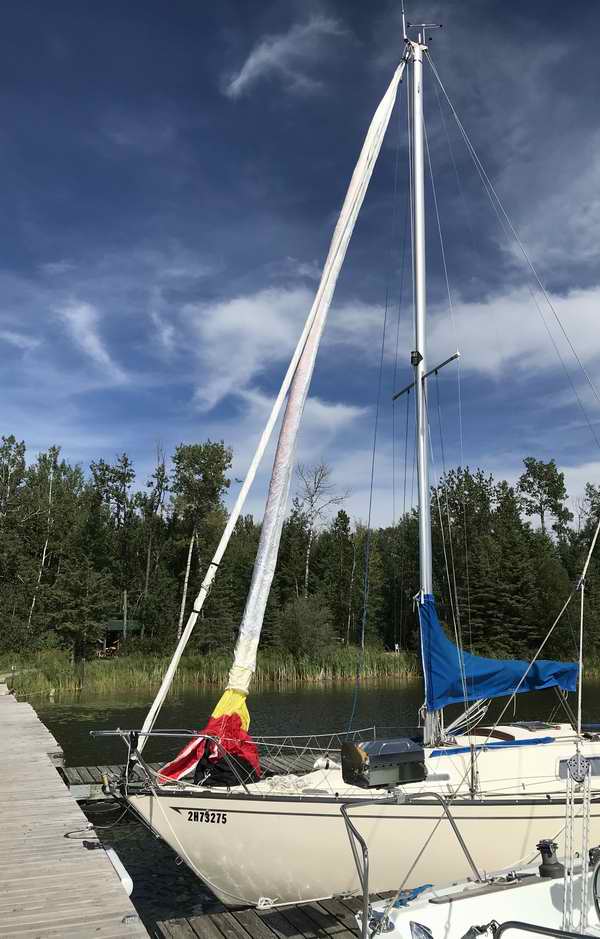| SJ23 Tech Tip F37, (Updated 2020-08-29) Bob Schimmel | |
|
How to Rig and Fly an Asymmetrical Spinnaker. |
|
|
Converting my SJ23 from hanked jibs to roller furling came with some
surprising changes, one of which involved Panache's asymmetrical
spinnaker. The tack of the spinnaker used to attach to the forestay with a piston hank
and the height of the tack was controlled with a down haul line. But now that
Panache is equipped with roller furling the tack
has to be "attached" to the forestay with a tacker or a Dacron sleeve. Either device slips
around the furled jib with a smooth inside so it does not damage the cloth as it slides or rotates over
it. MAKE A TACKER - A DIY tacker can be made by cutting a curved section from a 4" diameter vinyl fender. My prototype is 9" long and wraps about 2700 around the furled jib. A heat gun did a good job of warming the top and bottom ends of the vinyl to gently roll the flanges out about 200 so the tacker can slide easier over the bumps of the sail cloth. A wood rolling pin or similar works well to nudge the soft vinyl outward. I might also wax the inside so it slides easier. The natural curve of the fender should fit well. A 1" wide nylon strap is wrapped around the middle of the vinyl and I stitched a snap shackle to each end. These were strongly stitched to the strap since this is what the tack of the spinnaker and the down haul line will be attached to. The nylon strap was also securely stitched and glued (Marine Goop) to the vinyl so the two stay together.
It slips easily up and down my furled 110% jib. |
|
|
All this should make it ready for a snag free launch on the downwind side of the bow.
HOIST - The spinnaker is hoisted to full height to the swivel block mounted on the masthead, forward of the forestay. For this reason the sheets are run forward of the forestay and outside the shrouds and jib sheets, back to the cockpit. In this configuration the spinnaker must be jibed around the forestay. The spinnaker sock is pulled up by the hoisting line, often assisted by the wind filling the spinnaker, and the hoisting line secured to a mast cleat. The free ends of the halyard, tack down haul and sheets end in the cockpit which is where I launch the spinnaker from. The tack downhaul line controls the height of the tacker, thereby shaping the luff. The tack is pulled down (luff tightened straighter) for sailing closer to the wind and released (luff loosened curved) to sail off wind. Alternatively it's also a way to keep the sail from stalling or to adjust for maximum speed, all balanced by sheet control. Take your pick. NO TACKER - To fly an asymmetrical spinnaker without a tacker I will use the existing down haul block attached to Panache's anchor roller. The alternative is to attach a block to a tack fitting, pulpit or bow sprit. The down haul line will control the tack height & luff tension of the spinnaker. The halyard and sheets are run as per usual, outside everything. The halyard will raise the spinnaker in its sock and the hoist line will raise the sock. The bottom of the hoist line may be secured to a cleat on the mast. Dousing the spinnaker is the reverse procedure. The North Sails Install a Gennaker launching bag has an excellent description applicable to many boats. JIBE - To jibe, pull in the main sheet to center the boom. Snug up the tack line as the spinnaker jibes easier with the luff snug. Release the spinnaker sheet to let it fly ahead of the bow. Turn the hull. Tighten the downwind sheet and release the mainsheet. Trim for speed. DOUSE - The spinnaker is doused by releasing the sheet and pulling the sock down via its control line, then stuffing it in the bag. Remember to clip the clew and tack to the ends of the bag and the head to the center. This helps to prevent hour glassing at the next hoist. Alternatively, you can release the tack snap shackle and pull the sock down in the lee of the mainsail. USEFUL LINKS - There are bits of useful information in each of the following videos.
Chutescoop, |
|
|
Return to Tech Tip Index. . . . . . . . . . . . . . . Have a Question? |
|
 I also intend to hoist and retrieve the
spinnaker using my "
I also intend to hoist and retrieve the
spinnaker using my " Finally, the two snap shackles were oriented in the same direction. With the release
pin pointed up, closing will be a one handed job, similar to pulling a
trigger with your finger. With the release pins pointed down release
might be easier. Time will tell which way is
better. Note
the brass swivel fitting at the tack above (there is a similar one at the head) to permit
an hour glass wrap to release itself, hopefully.
Finally, the two snap shackles were oriented in the same direction. With the release
pin pointed up, closing will be a one handed job, similar to pulling a
trigger with your finger. With the release pins pointed down release
might be easier. Time will tell which way is
better. Note
the brass swivel fitting at the tack above (there is a similar one at the head) to permit
an hour glass wrap to release itself, hopefully. 
 WITH
TACKER - The tacker is slipped
around the furled jib and the retaining snap shackle is clipped to the opposite
strap to secure the tracker around the forestay. The down haul line is clipped to the
strap. See photo above. The tack of the spinnaker is
then pulled to the free snap shackle and clipped there.
A snap shackle is used so it can be released under load. This
feature is
important to release the sail in an emergency so it can be doused in the lee of the mainsail
using the spinnaker sock. While this is usually considered an emergency safety
release instead of a normal dousing, some people use this procedure as
normal operation.
WITH
TACKER - The tacker is slipped
around the furled jib and the retaining snap shackle is clipped to the opposite
strap to secure the tracker around the forestay. The down haul line is clipped to the
strap. See photo above. The tack of the spinnaker is
then pulled to the free snap shackle and clipped there.
A snap shackle is used so it can be released under load. This
feature is
important to release the sail in an emergency so it can be doused in the lee of the mainsail
using the spinnaker sock. While this is usually considered an emergency safety
release instead of a normal dousing, some people use this procedure as
normal operation.